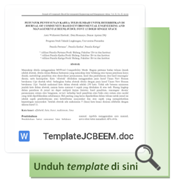LIFE CYCLE ASSESSMENT OF DOMESTIC WASTEWATER TREATMENT IN MEDAN CITY, INDONESIA
DOI:
https://doi.org/10.23969/jcbeem.v4i2.3362Keywords:
Life Cycle Assessment, Domestic Wastewater TreatmentAbstract
Medan City already has been having Waste Water Treatment Plant (WWTP) under PDAM Tirtanadi (North Sumatera Government) supervision, namely IPAL Cemara. IPAL Cemara is off-site sewerage system to treat domestic wastewater, includes black and grey water. IPAL Cemara has maximum capacity 60,000 m3/day, but recently, the number of treated households by IPAL Cemara is 18,396 households and the used capacity is less than 10,000 m3/day. This research analyses on operational phase of IPAL Cemara on environmental impacts, starts at wastewater influent from households and ending at release of wastewater effluent and disposal of dry sludge. The phase of reuse or recycle of effluent wastewater and dry sludge, and waste management are not included. Functional unit in this research is treatment of 7,171 m3 wastewater per day for a year. The system boundary starts at wastewater influent and ends at release of wastewater effluent. The characterization factors are tracked based on CML Baseline 2001 and all of data processed by Microsoft Excel. For the result, got that Aerated Pond has removal efficiency of BOD and COD more than 70%, but on the other hand, it is the largest contributor to Climate Change impact because of diesel consumption (16.97%), the amount of CO2 (4,95%), and N2O (4.26%) from biogenic emission, and electricity use (3.04%). The 65% reducing of TSS is occurred in UASB Reactor but UASB Reactor also as contributor for Climate Change impact (16.63%) and Photo-Oxidant Formation impact (29.34%) due to the highest production of CH4. Facultative Pond contributes 49% of Climate Change impact and 31% of Photo-Oxidant Formation impact because of the highest production of CH4. Based on normalized by impact category, Freshwater Ecotoxicity and Eutrophication is the largest environmental impact in a whole system of IPAL Cemara. Freshwater Ecotoxicity caused by 72% CS2 at Release of Wastewater and Eutrophication caused by 41.25% of NH3 and 39.60% of N. It is Align with the result of normalized by Life Cycle Stage, shows that the Release of Wastewater Effluent is the largest contributor to environment in a whole system of IPAL Cemara.
Downloads
References
Australian National Greenhouse Accounts. (2015). Australian National Greenhouse Accounts Factors, Department of Environment, Commonwealth of Australia, 78 p.
Brander, M.,Sood, A., Wylie, C., Haughton, A., Lovell, J. (2011). Electricity-specific emission factors for grid electricity. Technical paper, Ecometrica, 22p.
Foley, J., de Haas, D., Hartley, K., Lant, P. (2010). Comprehenshive life cycle inventories of alternative wastewater treatment systems. Water Research, 44(5), 1654-1666.
Li, Y., Luo, X., Huang, X., Wang, D., Zhang, W. (2013). Life Cycle Assessment of municipal wastewater treatment plant: a case study in Suzhou, China. Journal of Cleaner Production, 57, 221-227.
Mcnamara, G., Fitzsimons, L., Horrigan, M., Phelan, T., Delaure, Y., Corcoran, B., Doherty, E., Clifford, E. (2016). Life Cycle Assessment of Waste Water Treatment Plant in Ireland. Journal of Sustainable Development of Energy, Water and Environment System, 4(3), 216-233.
N.C. RTI International. (2010, December). Greenhouse Gas Emissions Estimation Methodologies for Biogenic Emissions from Selected Source Categories : Solid Waste Disposal, Wastewater Treatment, Ethanol Fermentation. Retrieved from https://www3.epa.gov/ttnchie1/efpac/ghg/GHG_Biogenic_Report_draft_Dec1410.pdf.
Prinajati, P.D. (2020). Domestic Communal Wastewater Treatment Plant Evaluation in Sindangrasa, Bogor, Indonesia. Journal of Community Based Environmental Engineering and Management, 4(1), 31-36.
Sleewijk, A.W., Oers, L.F.C.M., Guinee, J.B., Struijs, J., Huijbregts, A.J. (2008). Normalisation in product life cycle assessment: An LCA of the global and European economic systems in the year 2000. Science in The Total Environment, 390(1), 227-240.
Turovskiy, I. S. 2006. Wastewater Sludge Processing. U.S. : Library of Congress Cataloging –in Publication Data.
Yustiani, Y.M., Pradiko. H., Amrullah, R.H. (2018). The study of deoxygenation rate of Rangkui River water during dry season. International Journal of Geomate, 15(47), 164-169.
Zang, Q.H., Wang, X.C., Xiong, J.Q., Chen, R., Cao, B. (2010). Application of life cycle assessment for an evaluation of wastewater treatment and reuse project – Case study of Xi’an, China. Bioresources Technology, 101(5), 1421-1425.
http://www.gdrc.org/uem/lca/lca-define.html (accessed March 2017)
https://www.iges.or.jp/en/pub/wastewater-management-systems-indonesia/en (accessed March 2017)














